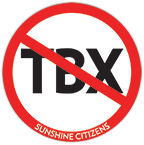By: Howard Harris
Tampa is changing. One way streets are disappearing. They use to transport people from Pasco County and Plum Nellie (Plum out of town and Nearly out of the county) into the city in the mornings and out in the evening. That scenario has changed. Tampa’s dense urban core is now attractive to businesses, young people and seniors. As a result, restaurants and other business establishments are vibrant after 5pm and downtown Tampa is no longer a ghost town after dark.
Downtown Tampa’s booming business environment has spawned serious traffic and parking congestion problems. However, Hillsborough County (HCO) officials cannot agree on an urban/suburban transportation plan and Tampa Bay Express (TBX) apparently does not recognize the aforementioned changes. Instead, TBX appears to rely on an out of date twenty plus year study which requires the obscene destruction of a swath of the established neighborhoods of Tampa Heights, Seminole Heights, West Tampa, and Carver City. This destruction will involve about homes, businesses, public gardens, a sorority house, a community center, at least one church, and possibly one or two relatively new low income housing apartment complexes. One of these complexes is within a football field’s distance of Blake high School.
TBX’s shows these doomed structures as little red triangles on their maps. Each of these triangles also represent hundreds of people who TBX will force to become urban refugees in a city running short of urban living spaces. Additionally, according to Politifact, carbon pollution will soon cause coastal refugees as well because of land lost to sea level rise created by more roads and more cars.
So, Tampa Bay cannot afford TBX’s fix for a six hour rush hour commute problem mainly for the well-heeled suburbanite. Tampa Bay cannot allow TBX to tie up traffic for 15 years while this Lexus Toll Road pink elephant is built. Tampa Bay cannot abide the creation of hundreds of urban and coastal refugees competing for living spaces.
These are the reasons that HCO and TBS should start over and establish a “No New Major Road Construction Policy. This would remove from consideration toll roads, light rail, an upper tier for Gandy, etc. and force the consideration of myriad alternatives to reduce traffic congestion.
One such alternative would make express busses truly express. The Bus on Shoulder System (BOSS) permit buses to use interstate emergency lanes. These are successful in reducing travel time and congestion in over ten states. The direct costs of implementing BOSS along I-40 in North Carolina was about $2,000/mile, primarily for signs. Thus implementing BOSS along the nine miles of I-275 from Bearss Avenue to downtown Tampa would be a one-time cost of about $18,000 and not billions of dollars for a Lexus Toll Road boondoggle.
Coupled with BOSS, is the need to significantly increase bus ridership. This will not occur without solving the problem of getting riders from bus stops to their jobs, homes and other destinations. A solution model is close at hand. Pinellas Suncoast Transit Authority has a first in the country pilot program that will pay Uber and United Taxi half the cost or up to $3 for a ride going to and from a bus stop.
Thus, a subsidized hybrid public/private high-functioning mass transit system would relieve traffic and parking congestion, leave communities intact, provide space for urban expansion, and reduce air pollution. It would also reduce auto insurance rates and other costs of auto ownership. Most importantly, Tampa Bay fatalities from traffic accidents could significantly be reduced from one of the highest in the nation at 12.6 deaths per 100,000 residents as reported in 2009.





